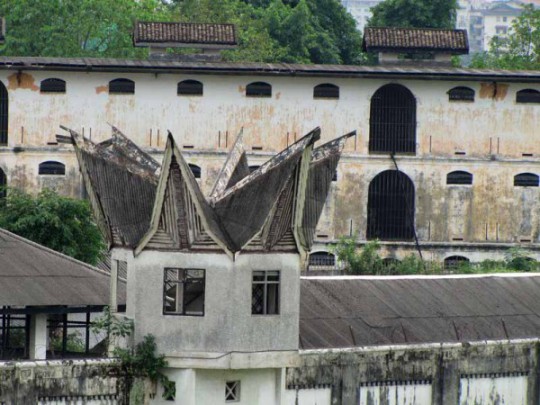 During 1942 my father Frank was incarcerated in Pudu Gaol, Kuala Lumpur, Malaya, He was a guest of the Imperial Japanese Army following his capture during the Battle of Muar in January, 1942.
During 1942 my father Frank was incarcerated in Pudu Gaol, Kuala Lumpur, Malaya, He was a guest of the Imperial Japanese Army following his capture during the Battle of Muar in January, 1942.
The gaol is located along Jalan Hang Tuah. During November, 2009 I was able to take some photographs of the gaol. I was in Kuala Lumpur for about eight days conducting some education technology workshops of behalf of AKEPT, the Malaysian Ministry of Higher Education and Nanyang Technological University Singapore. The workshops were held at the University Putri Malaysia and focusued upon eLearning Implementation & Web 2.0 Technologies in Higher Education. There were participants from each of Malaysia’s universities at the workshops.
While I was in Kuala Lumpur I took the chance to visit the gaol and take some photographs. I took most of the photographs from the Hang Tuah monorail station which partially overlooks the gaol. My father was in the gaol from late January 1942 through to the 30th September 1942.
Charlie Edwards, also a member of the 2/19th Battalion AIF with my father, wrote this account of life in Pudu Gaol in a letter to myself some years back.
“It would have been after this that he was taken prisoner. I was taken prisoner on the 22nd January 1942 and three days later entered Pudu Gaol. I recall that over the next fortnight small groups drifted into the gaol. Frank, as I recall, came in with Captain Reg Newton and Sergeant Sam Cameron, “D” Company, Quarter Master Sergeant. They were all in a very distressed state about the end of the first week in February 1942.
About the middle of March, well after the Fall of Singapore, we were moved, the Australians first into the gaol proper, from the very crowded and insanitary area of the Womens’ prison. Here the boredom of a P.O.W.’s life went on, and most of the men stricken with diaorrhoea or dysentery as well as malaria, and all on very tiny rations.
After a while the men started to succumb to three other diseases and all were diet deficiency diseases. Beri-beri, extreme tinea, and “happy feet”. With beri-beri the ankles, testicles and face all swell up like footballs. I recall on my way back from the tong a fellow said “good day Charlie”. I looked at him and all I could see was three slits, his two eyes and mouth, even his nose had disappeared. He was unrecognisable.
Tinea started at the scrotum and continued in about a four inch strip down to the knees on the inside of the legs. The itch was unbearable, and if you scratched it, it only became worse. The only remedy we had was coconut oil, and when we applied this we could hardly stand it. “Happy Feet” was like having pins and needles in the feet only about ten thousand times worse than ordinary. Frank would have suffered at least two of these diseases.
Days ran into weeks and weeks into months. It must have been into May when we had a change of administration to a Naval camp Commandant who was much more lenient. We all said he have been round the world a little bit more and learnt to be a bit more compassionate. He introduced a canteen where we we were allowed to buy peanuts, bananas, and other fruit and tobacco. With these extra nutrients these diseases disappeared.
So life in Pudu went interminably on until about the first weeks in September, when rumours began to fly that we would be moving. So, on the 30th September, 1942, the Australians were moved by train to Singapore.
On our arrival in Changi it was almost like coming home. Everyone was well dressed and looking fit. In Pudu the Japs had given us nothing, we were in rags, some of the men were still eating out of hub caps and coconut shells.”
When I visited the prison and took the photographs from the vantage point of the metro station I stood there and wondered how could my father exist and survive in such terrible conditions. No connection with the outside world. Disease, the threat of death at any moment, simply not knowing.
Charlie Edwards drew a map of the gaol and he sent me a copy. Click on the map to view a larger copy of the map.
I took a series of shots using the panorama feature of my camera and I stictched the images together using Photoshop Elements. Took a while to merge the nine different images however I am happy with the final result. Click on the image below to view the panorama (8600 x 1150 pixels; 2.3mb). It may take a while to download.
Interestingly, I shared the story of my visit to the gaol with the participants of the workshop and mentioned how I had attempted to seek permission, without success, to photograph of the prison from the Berjaya Times Square building opposite. Coincidentally one of the participants, Kristy Christie, also worked in an office in that building and she was able to take some photographs of the prison from an elevated position.
The western wall of the prison was demolished recently to make way for road widening and as some of the links below reveal the gaol is scheduled for demololition.
[This post is a cross post from my Prisoner of War site dedicated to my father Frank Larkin. The entire post with a gallery of 36 photographs of the prison is located here: Pudu Gaol, Kuala Lumpur ] Links and galleries- Wikipedia: Pudu Prison
- Google Maps: Pudu Gaol
- Google Earth: KMZ Placemark for Pudu Gaol
- The Fall of a 115 Year Old Wall
- Farewell Pudu Prison
- Pudu Gaol Flickr Group
- Magnus Caleb’s photostream: pudujail
- Ervin Noordin: Pudu Prison 1895 – 2010
- Photographs of Pudu Gaol
- Facebook: Pudu Prison
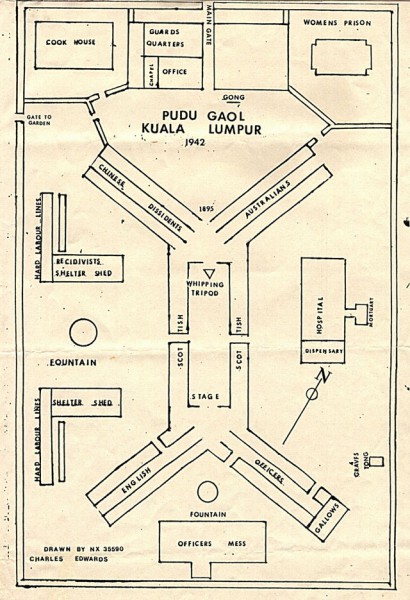

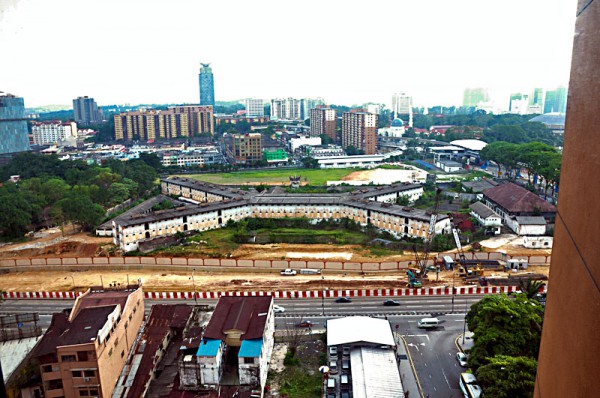
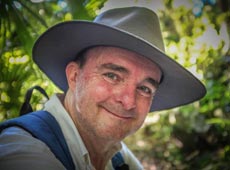






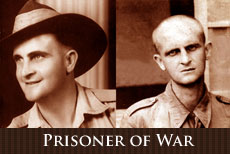
Aug 18, 2011 @ 03:45:36
I’M trying to find who to get in touch with regarding a previous prisoner in the prison, is there any sort of historcal records or someone i can contact? Thanks
Sunny pudu | Zwear
Aug 23, 2011 @ 09:49:10
[…] Pudu Gaol, Kuala Lumpur, Malaysia | John LarkinJun 26, 2011 … During 1942 my father Frank was incarcerated in Pudu Gaol, Kuala Lumpur. … A sunny afternoon. A warm place. A cat. Good weather. … […]
May 27, 2014 @ 22:21:46
Hi John – you may be interested in a book I recently published (on Blurb – a ‘print on demand’ service for authors) called The ‘Good Brothers’ of Pudu: A Chinese Malaysian Community of Kuala Lumpur. Basically its a bit of a history of early KL – focusing on Pudu – up to about 1910. It doesnt cover Pudu Gaol during WWII but gives a little info about its early years:-
http://www.blurb.co.uk/b/4789693-the-good-brothers-of-pudu-a-chinese-malaysian-comm
I also see you have an interest in Australian History. I also published a book called ‘The Ulva Families of Shotts’ (Ulva, an island in Scotland, was the home of Lachlan Macquarrie Governor of NSW), which may interest you (Shotts was my hometown in Scotland) :-
http://www.blurb.co.uk/user/store/mcanna
For more on my Pudu book see the folowing article which appeared in The Star newspaper of Malaysia. Even if you dont buy anything could you please let friends and colleagues know about them:-
http://www.thestar.com.my/Lifestyle/Books/News/2014/02/02/Digging-into-Pudus-past/
Rgs Jim McAnna